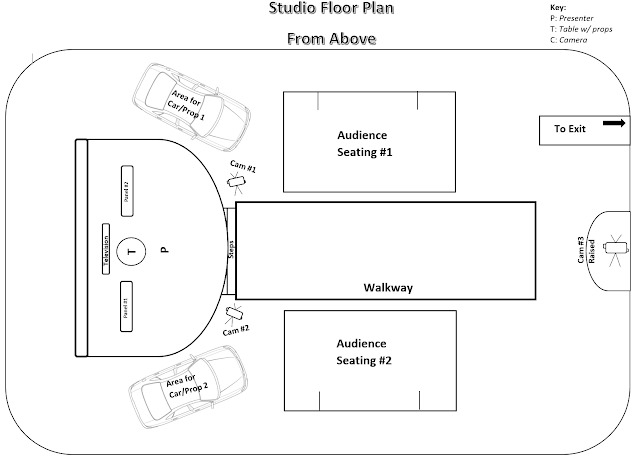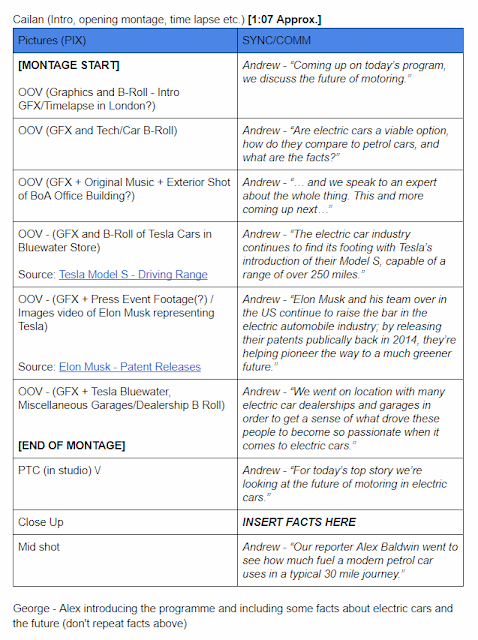Contextual Studies: Mise En Scene
Mise en Scene is crucial to what television and film are about - a visual medium. It is important to be able to understand and interpret mise en scene (e.g. Semiotics)
Definition: What is actually being seen on the scene or visual frame.
Mise en scene originates from theatre, defining the placement of objects and characters within plays.
Key Elements of Mise en Scene:
Costume: what the visual look of characters conveys (e.g., good vs bad)
Staging/Stage Directions: The placement of characters and props - the way in which they act with body language.
Props/Production Design/Setting: This includes items that are used by characters, purposeful decisions on the design of the set/location as well as colour choices.
Lighting: how it affects setting and character (e.g., shadows for villains and thrillers)
STAR WARS (George Lucas, 1977)
Setting: Sci-fi
Costume: Very simplistic, black means bad (sith), white means good (jedi).
Interpreting Mise en Scene:
- How we read mise en scene depends on our interpretation of visual codes, signs and symbols.
- Semiotics: the study of sifns and their meaning (from semeiotikos: 'interpreter of signs')
- Denotation/Signifier - the sign (word, colour, image.)
- Connotation: the hidden meaning behind something.
Context and mise en scene:
- How we interpret or decode elements of mise en scene also depends on cultural context.
- The commutation test: changing use or an element of the sign to see how this effects interpretation.
Star Wars and The Matrix are both Hollywood SF/Fantasy genre films inspired by Asian culture, Star Wars adheres to classical 'Western' convention (protagonists wear white, etc.)
The Matrix adopts a more culturally diverse model using Asian archetypes (ghosts/spirits wear white; protagonists may dress in black).
Game of Thrones - Tyrion and Cersei in King's Landing
Setting: Grand, perhaps a castle, wind coming in through the windows, sounds of harbour echoing in the background, signifies importance, high up location, wealth. Warm, rich, exotic.
Costume/makeup: Wearing red and gold, gold being everywhere, connotes wealth and importance. Luxurious, contrasts. Red generally has a negative connotation.
Lighting: Bright in the room, perhaps could signify the time of day - mid afternoon(?).Soft, natural, fill light. Net curtains covering the balcony in the background helps achieve a softer lighting effect.
Staging: The way in which Cersei is sitting, her posture and positioning, conveys female dominance. She is the one in control over Tyrion within the scene.
Game of Thrones - Jon Snow rallies the Night's Watch to go on a suicide mission
Setting: A lot darker, more gritty. Lacks the luxury of The Red Keep in King's Landing. Cold, austere, masculine.
Costume/makeup: Large dark cloaks helps signify not only the necessity of warmth in such a cold environment, but also a much more serious, darker tone. The Night's Watch aren't allowed to relax, they defend Westeros from the threats that lie beyond the wall. Uniformity.
Lighting: Cold, blue light - lower colour temperature. This is linked with the wall's association with ice. Very harsh, strong light... key lighting on Jon Snow's face. No artificial lighting, all lighting was coming through the gaps in the structure.
Staging: The council of the Night's Watch are literally positioned higher than the rest of the group, signifying their superiority.
How does mise en scene help us in storytelling?
- Useful visual shorthand. Reinforces Steve Coombes' show, not tell rule.
- Can help define characters, their emotional state and status (class, occupation)
- Can help define relationships between characters through staging, lighting and framing.
- Action is character, what we do is as important as what we say.
TOWIE - Scripted Reality (documentary conventions but with scripted situations)
Setting: Hyperrealism, feels like a set stage. Minor artificiality about it, may be real however definitely exaggerated.
Costume/makeup: Glamour, aspirational? Perhaps they're meant to be role models for a younger generation whether this is the case or not.
Lighting: High key, very dramatic lighting, typically found in tv/theatrical drama.
Staging: Sitting on the sofa together, very casual... perhaps supposed to be relatable? Shot, reverse shot during dialogue (drama trope).
The Only Way Is Essex has blurred the line between drama and reality television.
Conventions of Documentary:
- Handheld camera footage
- Faces pixellated out of view in order to protect their identity.
Observational Documentary (Dispatches, Channel Four)
Setting: Authentic locations, no-where looks like a staged area.
Costume/makeup: Defines social class, the hairstyle, the choice of clothing is representative of a specific stereotype. 'Croydon Face-lift', working class young women. Links with cultural context.
Lighting: Purely natural lighting, convention of documentary. Small pools of lighting, low-key.
Staging: Contextual; suggests social isolation. Clearly the protagonist as the camera tracks her multiple times, she is in every frame.
Realism, classicism & mise en scene:
- Realism: the presentation of art as simulacrum of world as exists. Used to convey notions of authenticity, truth and representation.
- Classicism: the presentation of art as continuity with past; especially formal notions of aesthetics, form, design and content.
Nanook Of The North (1922, directed by John Flaherty)
Famous classic documentary following the lives of inuits living in the Arctic. Lighting was an issue as older cameras needed a massive amount of light in order to produce a decent image. To do this the filmmakers had to remove the top of the igloo in order to receive additional lighting from the sun.
YouTuber - Phillip DeFranco (4.8million subscribers)
- Constructed set emulates 'geek' bedroom. Items in the background change every video, however consistently relate to either the topic of the video or general pop culture.
- Costume is supposed to be regular, relatable. He represents the standard, average joe. Signifies 'blue collar' authenticity.
MISE EN SCENE IN DRAMA (checklist)
Setting: Film & TV drama classically used studio sets. Often look very authentic.
Costume/makeup: Artificial, designed as character-specific.
Lighting: High-key lighting is classic for drama, even if stimulated by natural lighting.
Staging:
MISE EN SCENE IN DOCUMENTARY (checklist)
Setting: Classically uses 'real' locations.
Costume/Makeup: Typically authentic, but can be directed.
Lighting: Traditionally 'natural', but often artificial/designed.
Staging: Typically 'natural', but often director-specific.
Definition: What is actually being seen on the scene or visual frame.
Mise en scene originates from theatre, defining the placement of objects and characters within plays.
Key Elements of Mise en Scene:
Costume: what the visual look of characters conveys (e.g., good vs bad)
Staging/Stage Directions: The placement of characters and props - the way in which they act with body language.
Props/Production Design/Setting: This includes items that are used by characters, purposeful decisions on the design of the set/location as well as colour choices.
Lighting: how it affects setting and character (e.g., shadows for villains and thrillers)
STAR WARS (George Lucas, 1977)
Setting: Sci-fi
Costume: Very simplistic, black means bad (sith), white means good (jedi).
Interpreting Mise en Scene:
- How we read mise en scene depends on our interpretation of visual codes, signs and symbols.
- Semiotics: the study of sifns and their meaning (from semeiotikos: 'interpreter of signs')
- Denotation/Signifier - the sign (word, colour, image.)
- Connotation: the hidden meaning behind something.
Context and mise en scene:
- How we interpret or decode elements of mise en scene also depends on cultural context.
- The commutation test: changing use or an element of the sign to see how this effects interpretation.
Star Wars and The Matrix are both Hollywood SF/Fantasy genre films inspired by Asian culture, Star Wars adheres to classical 'Western' convention (protagonists wear white, etc.)
The Matrix adopts a more culturally diverse model using Asian archetypes (ghosts/spirits wear white; protagonists may dress in black).
Game of Thrones - Tyrion and Cersei in King's Landing
Setting: Grand, perhaps a castle, wind coming in through the windows, sounds of harbour echoing in the background, signifies importance, high up location, wealth. Warm, rich, exotic.
Costume/makeup: Wearing red and gold, gold being everywhere, connotes wealth and importance. Luxurious, contrasts. Red generally has a negative connotation.
Lighting: Bright in the room, perhaps could signify the time of day - mid afternoon(?).Soft, natural, fill light. Net curtains covering the balcony in the background helps achieve a softer lighting effect.
Staging: The way in which Cersei is sitting, her posture and positioning, conveys female dominance. She is the one in control over Tyrion within the scene.
Game of Thrones - Jon Snow rallies the Night's Watch to go on a suicide mission
Setting: A lot darker, more gritty. Lacks the luxury of The Red Keep in King's Landing. Cold, austere, masculine.
Costume/makeup: Large dark cloaks helps signify not only the necessity of warmth in such a cold environment, but also a much more serious, darker tone. The Night's Watch aren't allowed to relax, they defend Westeros from the threats that lie beyond the wall. Uniformity.
Lighting: Cold, blue light - lower colour temperature. This is linked with the wall's association with ice. Very harsh, strong light... key lighting on Jon Snow's face. No artificial lighting, all lighting was coming through the gaps in the structure.
Staging: The council of the Night's Watch are literally positioned higher than the rest of the group, signifying their superiority.
How does mise en scene help us in storytelling?
- Useful visual shorthand. Reinforces Steve Coombes' show, not tell rule.
- Can help define characters, their emotional state and status (class, occupation)
- Can help define relationships between characters through staging, lighting and framing.
- Action is character, what we do is as important as what we say.
TOWIE - Scripted Reality (documentary conventions but with scripted situations)
Setting: Hyperrealism, feels like a set stage. Minor artificiality about it, may be real however definitely exaggerated.
Costume/makeup: Glamour, aspirational? Perhaps they're meant to be role models for a younger generation whether this is the case or not.
Lighting: High key, very dramatic lighting, typically found in tv/theatrical drama.
Staging: Sitting on the sofa together, very casual... perhaps supposed to be relatable? Shot, reverse shot during dialogue (drama trope).
The Only Way Is Essex has blurred the line between drama and reality television.
Conventions of Documentary:
- Handheld camera footage
- Faces pixellated out of view in order to protect their identity.
Observational Documentary (Dispatches, Channel Four)
Setting: Authentic locations, no-where looks like a staged area.
Costume/makeup: Defines social class, the hairstyle, the choice of clothing is representative of a specific stereotype. 'Croydon Face-lift', working class young women. Links with cultural context.
Lighting: Purely natural lighting, convention of documentary. Small pools of lighting, low-key.
Staging: Contextual; suggests social isolation. Clearly the protagonist as the camera tracks her multiple times, she is in every frame.
Realism, classicism & mise en scene:
- Realism: the presentation of art as simulacrum of world as exists. Used to convey notions of authenticity, truth and representation.
- Classicism: the presentation of art as continuity with past; especially formal notions of aesthetics, form, design and content.
Nanook Of The North (1922, directed by John Flaherty)
Famous classic documentary following the lives of inuits living in the Arctic. Lighting was an issue as older cameras needed a massive amount of light in order to produce a decent image. To do this the filmmakers had to remove the top of the igloo in order to receive additional lighting from the sun.
YouTuber - Phillip DeFranco (4.8million subscribers)
- Constructed set emulates 'geek' bedroom. Items in the background change every video, however consistently relate to either the topic of the video or general pop culture.
- Costume is supposed to be regular, relatable. He represents the standard, average joe. Signifies 'blue collar' authenticity.
MISE EN SCENE IN DRAMA (checklist)
Setting: Film & TV drama classically used studio sets. Often look very authentic.
Costume/makeup: Artificial, designed as character-specific.
Lighting: High-key lighting is classic for drama, even if stimulated by natural lighting.
Staging:
MISE EN SCENE IN DOCUMENTARY (checklist)
Setting: Classically uses 'real' locations.
Costume/Makeup: Typically authentic, but can be directed.
Lighting: Traditionally 'natural', but often artificial/designed.
Staging: Typically 'natural', but often director-specific.


Comments
Post a Comment